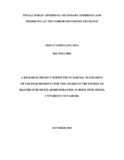| dc.description.abstract | The ideal pricing of an offering is that issue price should be equal to the fundamental or
intrinsic value of a company because this is the optimum price for all the parties involved in
the process as the issuing company, underwriters and investors. However, this price is rarely
achieved in offering because certain subjective considerations are made in determining issue
prices that do not influence nor are influenced by the underlying fundamentals of the issuing
companies. It is this relationship between the fundamental value at the time of offering and
the selected issue prices that is the focus of this research project. In determining whether a
particular initial public offering or secondary offering has been underpriced or overpriced,
most studies compare the initial day closing price as a substitute for the fundamental value
under the assumption that full price adjustment usually takes place on the first day of trading
and thereafter prices react to the flow of news. But the 1st day closing price can hardly be an
efficient proxy since it is also an equilibrium of demand and supply which are influenced by
subscription and allotment rates. Several studies including Purnanandam and Swaminatham
(2004) recommend the need for a more realistic approach in determining fundamental values
for the purpose of establishing underpricing or overpricing. In this particular study a net asset
valuation or the book value per share basis was used to determine the intrinsic values at the
time of the offering utilizing the pre offer financial position to determine the underlying value
per share and comparing it with the offer price to determine whether an offering was
over/under priced. This study was a census of all quoted companies since they all had the
common characteristic of having issued some of their equity to the public at one point or
another, however, due to non availability of prospectus information, a final sample of
nineteen offerings that were carried out between the year 1992 and 2014 was settled on. The
results that were obtained after a detailed analysis were mixed, with 68% of the sampled
companies showing that they were significantly overvalued at the time they went public by an
average of 99%. IPOs returned a mean overpricing of 142% while Secondary Offerings had a
mean overpricing of 75% which is in line with Mbithi (2013) who found a mean overpricing
of 59.9% on a sample of 5 IPOS using a retrogressive discounted cash flow technique. | en_US |

